[This article was published in 2008, is super outdated 🙂 ]
********
Index
– Training
– Scientific, medical and research
Updates
[19 Nov 2010 : Added link to Ford’s VR Facilities] [18 June 2010 : Added link to DIVA – Database navigation] [15 June 2010 : Added link to VR design tools at Ford] [15 May 2010: Added Clarte’s VR4D – VR For Design] [12 Aug 2009: Added virtual surgery article] [07 June 2009: Added some info in the research section] [03 Apr 2009: Added link to VR at Ford] [23 Jan 2009: Added link to surgeon training articles] [6 Dec 2008: Added link to Motek videos in Medical section] [25 Nov 2008: Added link to Dr Rizzo interview on therapies in Medical section] [07 Oct 2008: Added excerpts from Ford article in Design/Prototyping section] [28 Aug 2008: Added link the Everyday object prototyping article] [4 Aug 2008: Added link to Miners traning and Agoraphobia treatment articles] [23 Jul 2008: Added Sivic, VR Learning Mastic Videos in Training section] [1 Apr 2008: Added paranoia study article link] [25 Mar 2008: Added phobia treatment article link] [29 Jan 2008: Added autistic children therapy, Audi link, Panoramic Quake3 video] [17 Jan 2008: Added a link to Dentists training] [13 Jan 2008: Added a CaveUnrealTournament Video] [11 Jan 2008: Added the gambling addiction link]Design, prototyping
Car, aircraft, boat, tractors, household appliances manufacturers, and even factory planners are using VR to prototype their products. They can create interactive virtual prototypes for far less money and time than a real prototype.

© PSA Peugeot Citroën Mediatheque.
[youtube]http://www.youtube.com/watch?v=pBuNHqJrHHk[/youtube]
This has a lot of advantages. Products or work environments are tested in VR, potentially with the end user, and problems are identified early in the design process. Once these virtual prototypes are built, all the actors, engineers, designers, ergonomists, marketing and end users, can communicate around the project in a more efficient and sexy way than traditional forms like paper or movies.
[youtube]http://youtube.com/watch?v=sXqr6mkJmDc[/youtube]
“The number of expensive, physical models and prototypes can be radically reduced by CAVE, and this ultimately saves a lot of time and moneyâ€, says Andreas Enslin, Miele’s senior designer. (…)
“CAVE creates a quite different form of communication and cooperation. Marketers, designers and engineers can now deal with one issue simultaneously. Regardless of what comes up with me as a designer or engineer, I am able to immediately try it and see if it works. As everyone is seeing the same thing, those people who are not directly involved in the process of development and construction can also immediately see the consequences and effects of decisions.“ (…)
The speed gained is also expected to increase the willingness to experiment, Miele’s senior designer believes. “In this respect, our innovative strength will also increase. It has become much easier to try out something crazy in between.â€
From the article : “Carmaker embraces VR“, New Zealand Herald :
“We can understand it from a person’s perspectives, rather than what analytical tools tell us,” says Elizabeth Baron, an advanced visualisation technical specialist who carried out Ford’s virtual reality programme. (…)
Four years ago, the carmaker would have spent four to 10 weeks building prototypes each time engineers wanted to experience a different beltline height, Schiavone said.
But the Programmable Vehicle Model at the Immersive Virtual Reality – or iVR – lab can simulate the change at the touch of a button.”
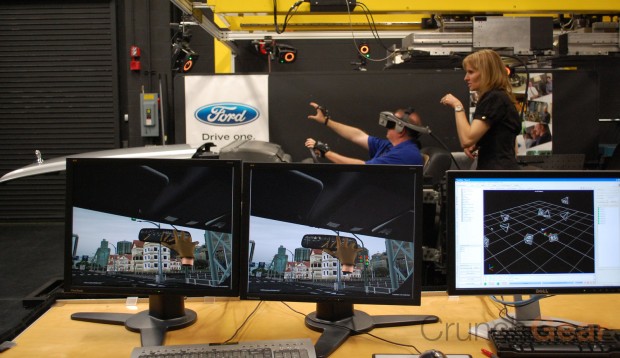
– Ford Programmable Vehicle Model (c) CrunchGear –
Clarte’s VR4D – VR For Design is a great example of place design :
[youtube]http://www.youtube.com/watch?v=XECqdtdY-Gc[/youtube]For more information : Ford’s VR facilities, Ford’s VR design tools, John Deere and VR, Mercedes and VR, Renault’s new VR screen, Renault’s VR design, Jaguar Land Rover and VR.
Marketing
VR is also used for marketing and pre-sales: potential clients can now test the product before it’s even finished, and be implied in the choice of configurations. For example you can take a walk in your future plane, and interactively place seats where you want. Even better, the system will make sure your decisions comply with security norms.
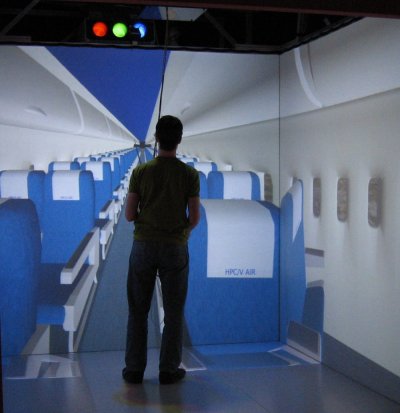
(c) University of Gronigen
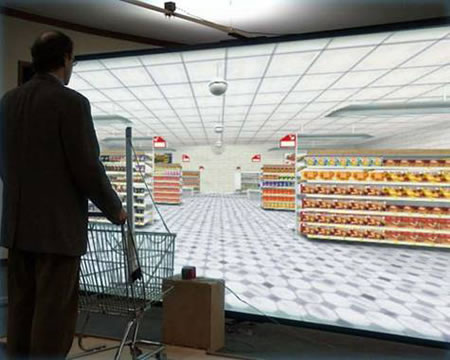
(c) Virtools
[flv]http://cb.nowan.net/images/vr/invirtuo.swf[/flv]Procter&Gamble and Kimberly Clark are using VR to create, in every detail, virtual stores to conduct marketing studies about product packaging, store layout and displays. With eye-tracking technologies, they can see precisely what aspect of their configuration influences your shopping experience and purchasing decisions.
More info : Virtual reality takes shopper to another world, Kimberly-Clark uses VR.
Training
One of the most fascinating aspects of VR is its ability to train people. A lot of companies and administrations are using VR to train their staff to complicated and/or dangerous procedures.
VR allows you to really perform the gestures, thus what you learn in the virtual environment is directly applicable to real life situations. Pilots get their flight certifications for some planes without ever flying this particular plane!
It also allows you to to test different scenarios instantly, review errors in slow motion and from different viewpoints, restart as many times as needed. Learning in such a simulator is a lot more efficient, and people are much more willing to take the training; the trainee is active in the simulator and acting alone as he would in real life, when before he was passive with other trainees, watching the teacher do the procedure or looking at photos on a CD.
VR learning environment provides a context that includes the multiple nature of human intelligence: verbal/linguistic, logical/mathematical, auditory, spatial, kinesthetic, interpersonal and intrapersonal.
The importance of affective learning has been carefully explored [Kohlberg 1968, Rogers 1969]. It is apparent that we must consider the whole learner in his or her effort to attain educational goals [Belkin 1977]. (…)
VR provides a context for both cognitive and affective learning by engaging us in a process that is rational and emotional, practical and whimsical, organized and spontaneous.  (…)
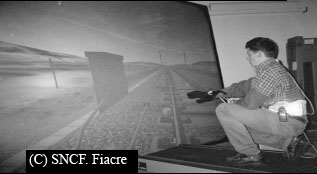
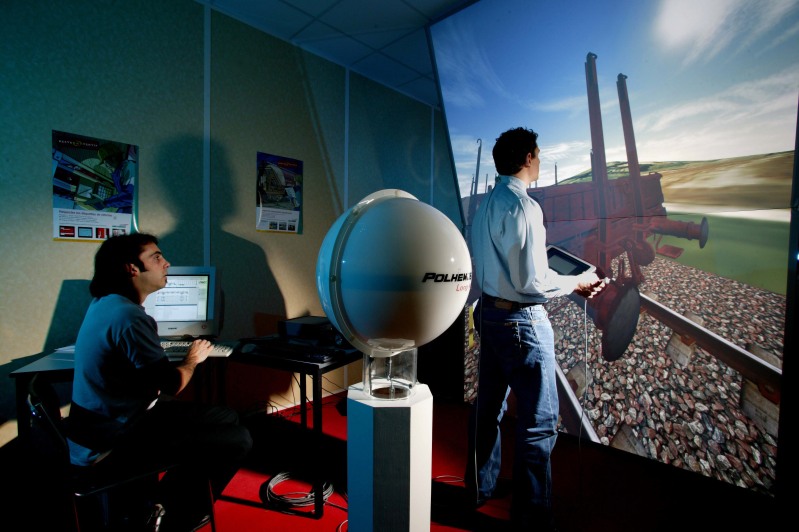
Fiacre, Simurat (c) D’Angelo SNCF
A recent article in the Nature magazine even suggests that VR medical training should be mandatory : “This approach has great potential to allow inexperienced physicians to acquire meaningful new procedural skills…without jeopardizing patient safety in the process”.

(c) Wired
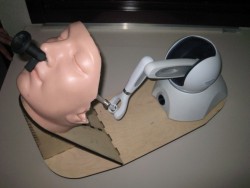
(c) Wired
From this article at Wired :
The new simulator consists of a small surgical camera, called an endoscope, and a mannequin head attached to a commercially manufactured touch-feedback device. As a doctor manipulates the endoscope through the nostril of the mannequin, he watches what’s happening on a computer screen above the “patient.†A computer program calculates how much resistance should be applied to the endoscope based on its location in the sinus cavity.
Because the device can simulate the anatomy of a specific patient, researchers hope it will be useful not just for new doctors, but also for senior surgeons who want to practice different approaches before a particularly challenging case. (…)
Blevins called the simulator a “reasonable representation†of what surgeons see and feel during a real operation, but he said the simulation is far from perfect. The device can sense motion in six different directions and give touch feedback in three, but that’s only enough to simulate simple surgical instruments, such as a drill, suction tube or camera.
“Interactions with tissue forceps and other kinds of graspers are more complicated and will take additional refinement,†Blevins said.
[youtube]http://youtube.com/watch?v=R81Af_DkPTg[/youtube]
[youtube]http://youtube.com/watch?v=Z2CdTyAO_dg[/youtube]
More info : VR for Training, VR for better surgeons, surgeons haptic training, Miner training, Haptik Implant (Dentists training, [FR]) First responders train with gaming technology, Scène de crime en 3D pour futurs policiers (Crime scene [fr]), Training Vets on a virtual cow,
Education : Teaching about Antique Rome in VR, Cyber-Anatomy.
Data Visualization
One of the oldest applications of VR, along with flight simulators, is data visualization. Mainly used in the oil and gas industry to study geological data and find new energy sources.
One good example is the DIVA application used to explore the structure of a database :
[youtube]http://www.youtube.com/watch?v=LpDyUAHuSLI[/youtube]
Architecture
VR allows the architects, engineers and clients to design a building, to valorize a project by showing it to a large audience, convince all actors, and do the maintainance of building. It also allows citizens to visualize and give their opinion about a project in their neighborhood.
[flv]http://cb.nowan.net/images/vr/cstb.flv[/flv](c) CSTB
More info : CSTB VR equipment
Scientific, medical and research
VR is particularly suited to study the human being. It allows the manipulation of a reality that is close enough to ours and conduct research on cognition, perception and psychology, that would not be practical or ethical to perform in real life (see the Redirected Walking, or Virtual reprise of Milgram’s obedience experiments). Moreover you can reproduce the exact same environment conditions indefinitely. For a good example of research lab, see what the Max Planck Institute lab in Tuebingen does.

(c) Centre de Réalité Virtuelle de la Méditérranée
Virtual Reality for therapeutical needs is a field that is also rapidly developping. Better therapies through VR are studied for speech therapy, physical therapy (video , Motek Caren video), some therapy for autistic children, motor rehabilitation after a stroke, even smoking, gambling, drugs and alcohol addictions ! And new areas are being explored everyday.

(c) GLEANER/STEPHEN MACGILLIVRAY PHO
It is also a very good tool to treat phobias in a controlled environment through exposure therapy. The subject can be immersed in a virtual world on a high bridge to treat fear of heights, or in a room with virtual spiders, or in the middle of a war to treat post-traumatic syndrome disorder (Agoraphobia, Virtual therapy video, “Medecine meets VR“, PTSD for 9/11, “Virtual Reality used to fight phobias“, “Paranoia Study“).
See also:
– Intrepid : University of Manchester’s project “ for the clinical treatment of phobic and situational « anxiety» “.
– University of Groningen VR Lab therapy researches
– VRPhobia
– Elhit
Entertainment
Despite what you may think, VR games seem to have practically disappeared. I haven’t seen any recent commercial attraction. The best VR games so far seem to be done by enthusiasts: Cave Quake 3 by Paul Rajlich, Cave Unreal Tournament by Jeffrey Jacobson, and Atrium Experience by Alexandre Bouchet and Lionel Dominjon. (Oh and Atrium will be shipped with Virtools/VR Library 2.5 😉

© Paul Rajlich

© Jeffrey Jacobson
[youtube]http://www.youtube.com/watch?v=yan8R4aZfhg[/youtube]
Cave UT in the SAS3

[youtube]http://www.youtube.com/watch?v=pagVgeFaR5Q[/youtube]
© Alexandre Bouchet, Lionel Dominjon
[youtube]http://www.youtube.com/watch?v=Cqh_F4iN8pg[/youtube]
Panoramic Quak3 (c) PanoramaScreen
http://www.youtube.com/watch?v=L7-BJTs2aHI
Thanks for the video!
What kind of software are you using at IIS3 ?
Who are the people on your team ?
You might be interested in the work of the Foundation of the Hellenic World, who make interactive (sometime communally!) VR and AR applications displayed in their Hellenic Cosmos Centre.
If you are interested in virtual heritage, the VAST conference is one you may want to check out. Not sure if its running this year, but previous year’s projects if you type into google. My be of interest to you.
I am working on a similar, desktop-only, VR project, reconstructing a fictional Hellenic sanctuary and incorporating mock historical sources and material evidence. It;s all about attemtping to involve history and VR in a way that is academically viable and appropriate. Further information abotu this will be posted in my blog (above) when the demo is completed if you, or any of your readers are interested.
Love the blog, its brilliant and clearly the result of a strong passion.
Hey Nathan thanks a lot for your comment, I’ll be watching this !
What tools are you using ?
cheers
cb
My website has a few details about my visualisation. You asked what tools i am using: just OpenGL and DevC++ (but the program’s written in C) and .tga’s, for textures, made with GIMP.
Have a look: http://www.classical-vh.co.uk – there’s not really any screenshots yet, but will be soon!